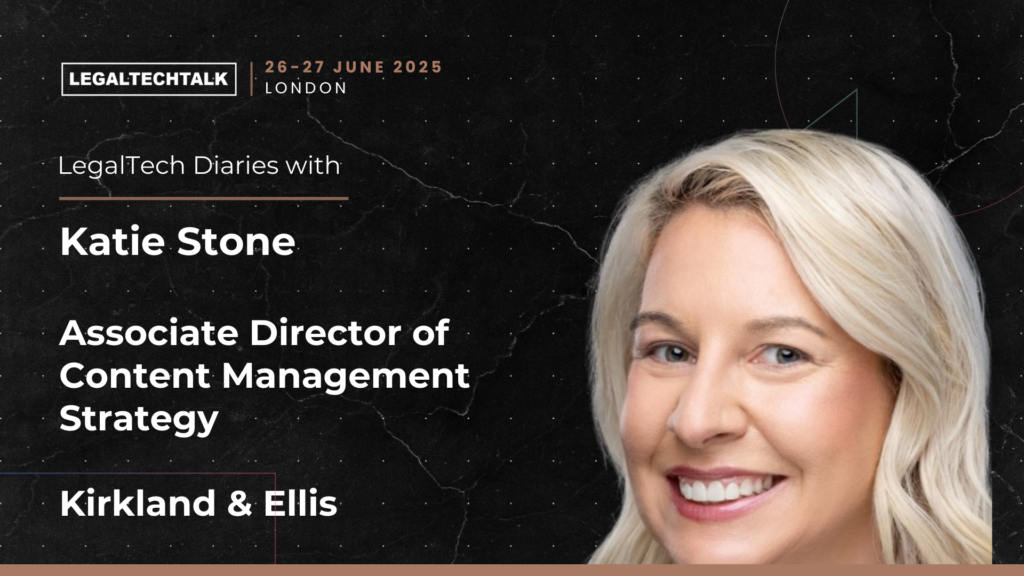In this interview, Katie Stone, Associate Director of Content Management Strategy at Kirkland & Ellis, discusses the challenges and opportunities in legal technology adoption with Charlotte Johnstone from LegalTechTalk. Katie emphasizes the importance of thorough research before implementing new technologies like generative AI and document automation. She outlines three key considerations for legal tech projects: identifying use cases, finding tech champions, and ensuring good data hygiene. Katie stresses the critical role of change management in successful tech adoption, highlighting the need for clear vision, resource availability, and result measurement. She predicts that law firms’ success in the next five years will largely depend on their ability to effectively communicate about and implement technology, advocating for an iterative approach to tech incorporation that starts with low-risk processes and gradually scales up.
Charlotte Johnstone: What do you think is the biggest challenge that law firms will have to face as we go through this period of seismic change?
Katie Stone: One of the biggest challenges will be determining the degree to which you adopt new technologies such as genAI, document-reading technology, or otherwise rote task automation. These technical advancements have already been proven to reduce many legal manual tasks and speed up processes like discovery, case filings, contract management, and much more. However, it’s critical to really do your homework and understand these technologies before blindly buying/building. There are three key questions to determine the scope of your legal tech projects:
i. What are your use cases for incorporating automation? What time savings will you earn?
ii. Do you have “tech champions” in these use case examples who will be your cheerleaders for the initiative?
iii. Do you practice good data hygiene? Is your data well organized, complete, and easy to find?
For instance, on the third question, I see a lot of firms out there who do not see, or choose to ignore, the fundamental benefit of incorporating a Knowledge Management or Data Management function internally ahead of launching new tech capabilities. As the old saying goes, “good data in, good data out”; if you don’t have a baseline of good data (i.e., taxonomies in place, a way to ensure data completion and data integrity, etc.), your end automation deliverables will fail to provide the time-savings and ROI you had expected. Remember that your data is one of the most valuable assets your firm owns, so curating it before you use it to automate your legal offerings is key.
Charlotte Johnstone: As a user adoption specialist, what are the key factors that drive the successful adoption of new systems and processes?
Katie Stone: True transformation is accomplished via sustainable change management, For the change to be successful, firms should ensure the following critical steps are taken. First, it’s important to create a vision for where your firm is headed as it illustrates to your people the connection between your mission and your day-to-day work. If you then explain how the new systems and processes get you closer to that vision, your folks are more likely to be on board and adaptive. This makes the discomfort of change a bit easier if they understand why the change is making their legal services better and more accurate. It is also critical to make resources available to your folks during the research, pilot, and implementation phases of new technologies and processes. Identify the individuals in your firm that are naturally “tech curious” and have a growth mindset. If you’re not lucky enough to have an in-house Technology Change/Process Management team, these individuals will be your biggest cheerleaders. Documentation is also helpful with exposing hidden efficiency gaps. Map your current processes and discuss with staff to understand what could streamline the process; could these process steps benefit from automation? Once new processes are finalised, ensure that user guides, FAQs, or process outlines are available, centralised, and easy to find in an intranet library or otherwise document management tool for your firm. Finally, be sure to measure your results. It’s important to be able to illustrate, in all-hands or quarterly partner meetings, the efficacy of the new process or tech platform that has transformed a section of the practice or an entire workflow.
Charlotte Johnstone: What do you think will be the biggest difference between the law firms that succeed and those that struggle over the next 5 years?
Katie Stone: I think the biggest differentiators will be how they talk to their firm about technology and their ability to implement said tech into their practices. There’s a lot of nervous energy among legal professionals, as well as legal operations staff, who fear that AI skills like search, document drafting, and brief creation may one day threaten their jobs. While the reality is that these highly skilled legal professionals will not be replaced in our immediate future, the benefit of incorporating AI in certain areas of practice wherein it replaces low-skill, manual tasks that do not inspire, nor motivate, people is massive. It frees your highly skilled legal and operational professionals to do the truly meaningful work and gives them back their time to make human connections with clients and colleagues. For this reason, you should be prepared to start having those discussions with your staff now, so that within the next couple of years of technical implementation they understand why and do not feel as threatened by it. So that’s the communication component.
The actual tech incorporation component is also paramount. A big factor is deciding how you will utilise the various legal tech tools out there on the market. I suggest an iterative approach where you start small with an innocuous process. When you choose a low-risk process to automate, you can then illustrate the wins to stakeholders without much pushback, and they will likely respond with a desire for more. Then, scale the automation opportunities with a larger data set or a larger pilot group so that you continue to see efficiency gains. By pushing tech/automation features out this way, you increase your “tech champions”, your spotlight of achievements, and positive user experiences. Conversely, these law firms who decide to turn a blind eye to these new tech capabilities will fail to retain clients and expand their practices at the same pace as those who adopt even a few of the available transformative capabilities out there.
Read full LegalTech Diaries Volume 5: https://www.legaltech-talk.com/legaltechdiaries/volume-5/








